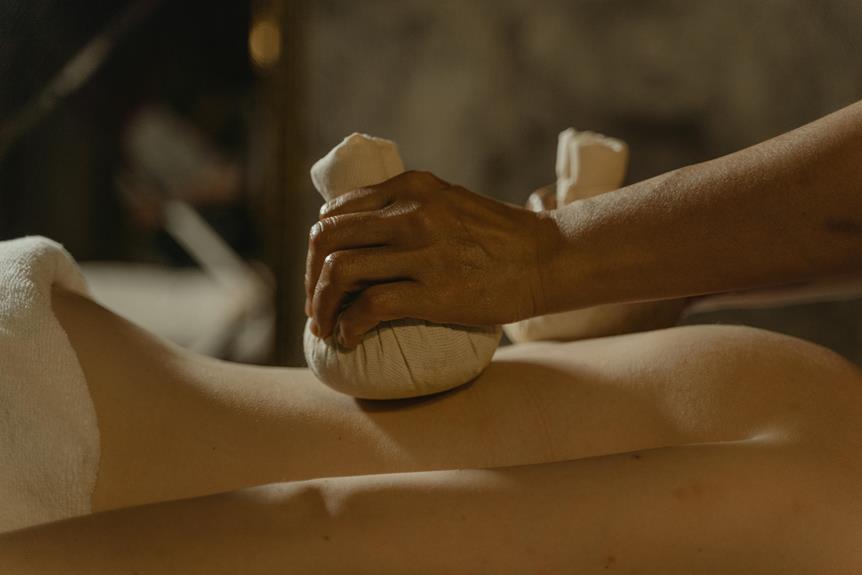When you're looking to elevate your laundry routine, combining tumbling with various fabric treatments can be an effective strategy. You might start by choosing treatments that complement each other, like fabric softeners for a plush feel or wrinkle sprays to keep your clothes looking crisp. However, the key lies in understanding how to integrate these treatments seamlessly during the tumbling process. What you do next could transform your laundry game entirely, so let's explore the best approaches to achieve optimal results without compromising your fabrics' integrity.
Table of Contents
Key Takeaways
- Check fabric care labels to ensure tumbling is safe before combining with treatments like fabric softeners or sanitizers.
- Use fabric softener during the wash cycle for added softness and combine with tumbling to enhance texture and reduce wrinkles.
- Incorporate wrinkle spray after tumbling to minimize creasing and freshen dress clothes effectively.
- Add a sanitizer during the wash to kill germs and odors, then tumble to enhance treatment effectiveness for gym clothes.
Understanding Tumbling Benefits
Tumbling not only enhances the texture of fabrics but also helps remove wrinkles and improve overall appearance. When you toss your clothes into the dryer, the tumbling action allows the fibers to relax, making them feel softer and more inviting. This process can be especially beneficial for items like towels and sheets, which can often feel stiff when air-dried.
Moreover, tumbling can help distribute any fabric treatments you've applied, ensuring they penetrate evenly throughout the material. This means that if you've used a fabric softener or a wrinkle-reducing spray, the drying cycle will help maximize its effectiveness. You'll notice that your garments not only look better but also feel smoother against your skin.
Additionally, the heat generated during tumbling can aid in killing off any lingering bacteria or allergens, making your fabrics more hygienic. It's a simple yet effective way to maintain the quality of your textiles.
Just keep in mind that not all fabrics are suitable for tumbling; always check care labels to avoid damaging delicate items. By understanding these benefits, you can make better choices for your laundry routine and enjoy fresher, more appealing clothes.
Best Fabric Treatments to Combine
To enhance the benefits of tumbling, consider using fabric treatments like softeners, wrinkle sprays, and sanitizers strategically during your drying cycle. Each of these treatments can elevate your laundry experience, ensuring your fabrics feel and smell their best.
Here's a simple guide to help you choose the right treatments:
| Treatment | Benefits | Best Use |
|---|---|---|
| Fabric Softener | Adds softness and reduces static cling | For towels and blankets |
| Wrinkle Spray | Minimizes wrinkles and freshens fabrics | For shirts and dress clothes |
| Sanitizer | Kills germs and eliminates odors | For gym clothes and bedding |
| Color Booster | Brightens colors and prevents fading | For dark or vibrant fabrics |
Step-by-Step Tumbling and Steaming
When you start tumbling your fabrics, understanding the techniques is key to achieving the best results.
You'll also want to explore effective steaming methods that can enhance your fabric treatments.
Let's break down these essential points for a successful process.
Tumbling Techniques Overview
Mastering the art of tumbling and steaming can elevate your fabric treatments, ensuring they look their best.
To get started with tumbling, gather your fabrics and choose an appropriate tumbler or dryer. Check the care labels first to ensure they're safe for tumbling. Set your machine to a low or medium heat setting to prevent damage.
Place your fabric inside, avoiding overcrowding to ensure even treatment. Start with short cycles, around 15-20 minutes, and check your fabric regularly. This helps you avoid over-drying, which can lead to shrinkage or stiffness.
Once the tumbling is complete, use the steam function if your machine has it. If not, you can mist your fabric lightly with water and then tumble for an additional few minutes. This process helps relax the fibers, giving your fabric a soft, fresh finish.
Effective Steaming Methods
Combining tumbling with effective steaming methods can significantly enhance the appearance and feel of your fabrics. To get started, first, ensure your fabric is clean and dry after tumbling. This prepares it for the steaming process.
Next, gather your tools: a steam iron or a handheld steamer. If you're using an iron, set it to the appropriate temperature for your fabric type. For delicate fabrics, use a low heat setting.
Begin steaming by holding the steamer or iron a few inches away from the fabric. Move it in a sweeping motion to avoid overheating any specific area. Focus on wrinkles or creases, allowing the steam to penetrate the fibers. For thicker fabrics, you may need to press the steam button multiple times.
If you're using a steamer, gently pull the fabric taut with one hand while steaming with the other. This helps release stubborn wrinkles. After steaming, allow the fabric to cool and dry completely before storing or using it.
Combining tumbling with these steaming methods not only revitalizes your fabrics but also keeps them looking fresh and new.
Ironing After Tumbling Techniques
After tumbling your fabrics, give them a quick press to eliminate any lingering wrinkles and restore their crispness. Ironing not only enhances the appearance of your fabrics but also helps to set any treatments you've applied during the tumbling process.
To make the most of your ironing session, consider these tips:
- Use the right heat setting: Adjust your iron to the appropriate temperature for the fabric type, ensuring you don't scorch delicate materials.
- Spritz with water: Lightly mist your fabric with water or use a steam function to help release stubborn wrinkles easily.
- Iron on the reverse side: For fabrics with prints or embellishments, iron on the reverse side to prevent damage.
- Work in sections: Divide your fabric into manageable sections to ensure thorough ironing without missing spots.
Using Fabric Softeners Effectively
When it comes to using fabric softeners effectively, choosing the right one for your laundry is crucial.
You'll want to apply it correctly and time it just right for the best results.
Let's explore these key points to ensure your fabrics come out soft and fresh every time.
Choosing the Right Softener
Choosing the right fabric softener can enhance the softness and overall feel of your clothes after tumbling in the dryer. With so many options available, it's essential to pick one that meets your needs and preferences. Here are some factors to consider when selecting a fabric softener:
- Scent: Decide if you prefer a light fragrance, a strong scent, or fragrance-free options.
- Type: Choose between liquid softeners, dryer sheets, or pods based on your laundry routine.
- Skin Sensitivity: If you or your family members have sensitive skin, opt for hypoallergenic or natural softeners.
- Performance: Look for products that specifically claim to reduce static cling and wrinkles, which can save you time on ironing.
Once you've identified what matters most to you, it'll be easier to narrow down your choices.
By selecting the right fabric softener, you can enjoy softer, fresher-smelling laundry every time you tumble dry your clothes.
Happy laundering!
Application Techniques Explained
To get the most out of your fabric softener, it's crucial to apply it correctly during your laundry routine. Start by reading the manufacturer's instructions on the softener bottle for the right dosage, as using too much can lead to buildup on your fabrics. Generally, you'll want to add the softener during the rinse cycle to ensure it distributes evenly.
Here's a quick reference table for effective application techniques:
| Technique | Description | Benefits |
|---|---|---|
| Direct Pouring | Add softener into the washing machine's designated dispenser. | Ensures even distribution. |
| Dilution | Mix softener with water before adding it. | Reduces concentration, preventing residue. |
| Pre-soak | Soak fabrics in a softener solution before washing. | Enhances softness and scent. |
| Scent Booster | Combine softener with a scent booster for extra fragrance. | Leaves a long-lasting scent. |
Timing for Best Results
Timing your fabric softener application is essential for achieving the softest and freshest laundry possible. To get the best results, you want to add the softener at just the right moment during the wash cycle. If you add it too early, it can wash out, and if you add it too late, it won't properly distribute through your clothes.
Here are some tips to keep in mind:
- Follow the instructions: Always check your washing machine's manual for the best time to add softener.
- Use the dispenser: If your machine has a softener dispenser, use it! It's designed to release the softener at the right time.
- Watch the rinse cycle: Add softener just before the rinse cycle starts for optimal results.
- Don't overload: Overloading the washer can prevent the softener from mixing well; give your laundry some space.
Tips for Optimal Results
For optimal results, always pre-treat fabrics with suitable solutions before tumbling to enhance their texture and longevity.
Start by choosing the right pre-treatment products based on your fabric type. For example, use a fabric softener for cottons and a stain remover for heavily soiled items.
Next, don't overload the tumbler. Giving your fabrics enough space allows for better circulation of air and heat, leading to a more effective treatment.
Keep an eye on the tumbling duration; longer isn't always better. Adjust the time based on the fabric's care instructions to prevent damage.
Additionally, consider the temperature settings. High heat can shrink or damage delicate fabrics, while lower settings mightn't yield the desired results.
It's also wise to check on your fabrics periodically during the tumbling process to ensure they're responding well.
Frequently Asked Questions
Can Tumbling Damage Delicate Fabrics Like Silk or Lace?
Yes, tumbling can damage delicate fabrics like silk or lace. It's best to avoid using a dryer for these materials. Instead, air-dry them to maintain their integrity and prevent any potential harm.
How Often Should I Tumble My Fabrics for Best Results?
You should tumble your fabrics every few weeks for optimal results. Monitor their condition; if they're delicate, adjust the frequency accordingly. Regular tumbling keeps them soft and reduces wrinkles without causing damage to most materials.
Are There Fabrics That Should Never Be Tumbled?
Yes, you should avoid tumbling delicate fabrics like silk, lace, or certain synthetics. They can lose shape or become damaged. Always check care labels to ensure your fabrics can handle the tumbling process without harm.
Is It Safe to Combine Tumbling With Dyeing Techniques?
It's generally not safe to combine tumbling with dyeing techniques. Tumbling can cause uneven dye distribution or damage to the fabric. Instead, consider completing dyeing first, then tumble dry to maintain quality.
What Are the Environmental Impacts of Fabric Tumbling Treatments?
When considering fabric tumbling treatments, you should be aware of the environmental impacts. These processes can consume significant energy and water, contributing to pollution and waste, which ultimately affects ecosystems and climate change.
- Tetron Fabric for Marine Applications: Durability and Use Cases - June 18, 2025
- Tetron Fabric for Outdoor Furniture: Weather Resistance and Care - June 18, 2025
- Tetron Fabric for Wall Coverings: Style and Application Tips - June 18, 2025







